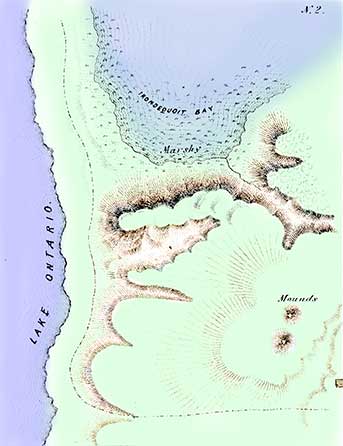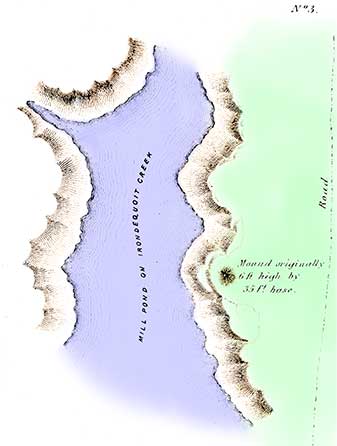MONROE COUNTY.
 |
| Plate VII. No. 2 |
They are small, the largest not exceeding five feet in height. It was found upon excavation that they had been previously disturbed; and their examination proved fruitless. Some bits of charcoal and a few small fragments of bones were observed mingled with the sand. At various places, upon the elevations around them, were scattered fragments of pottery, and arrow-heads and other rude relics are also of frequent occurrence here.
The spot was evidently a favorite one with the Indians, the vicinity abounding in fish and game.
The waves of the lake have thrown up a narrow bar or bank of sand, called the "Spit," which extends nearly across the mouth of the bay, leaving but a small opening. Upon this bar, a few scattered trees are standing, and it was here that the Marquis De Nonville landed with his troops, at the time of his expedition against the Senecas, in 1687. He constructed a stockade at or near this point.
Upon the eastern shore of the bay, and occupying a position corresponding with that of the mounds already described, it is said there is another mound of considerable size. It was opened many years ago, and was found to contain human bones.
 |
| Plate VII. No. 3 |
As already observed, most, if not all, of the ancient works which existed in this county are now obliterated. We can consequently do but little more than indicate the sites which they occupied according to the best information obtained from the early settlers. It is asserted that an enclosure of considerable size exists in the town of Irondequoit, west of Irondequoit Bay, and near the Genesee River, about five miles north of Rochester. A day was spent in search of it, but without success. Its discovery may reward the perseverance of some future explorer.9
A fine work once occupied a commanding site at the point known as "Handford's Landing," three miles north of Rochester. It consisted of a semicircular embankment, the ends of which extended to the very edge of the immense ravine which shuts in the Genesee River below the falls at Rochester. It had three narrow gateways placed at irregular intervals.
There is a locality in the town of Parma, about seven miles west of Rochester, where the earth has subsided into the fissures of the sand rock, forming what has generally been supposed to be a line of entrenchments. From some distance the apparent ditch has all the regularity of a work of art; but still it is hard to understand how it came to be regarded as an "Indian Fort," by which name it is currently known in the neighborhood. It would seem incredible that errors of this kind should become general, had not a large experience shown that upon no class of subjects do the mass of men exercise so little sound judgment, as upon those which relate to the history and monuments of the past.
In the town of Ogden, which adjoins Parma on the south, it is reputed that some ancient works are to be found; but from the best information which could be obtained, it seems probable that the report has no better foundation than hundreds of similar ones, and originated, it is very likely, in the discovery of an Indian cemetery, or of the traces of an Indian village.
Ascending the valley of the Genesee for twenty miles, we come to a section of country which is very rich in evidences of aboriginal occupancy, but chiefly such as may be referred to a comparatively late date. In the town of Wheatland, and a short distance to the westward of the village of Scottsville, there formerly existed two very interesting earth-works. There is scarcely a trace of them now to be seen. They were visited by Kirkland in 1788. He found the first work "about two miles west of Allen's residence, which was an extensive flat, at a deserted Indian village near the junction of a creek (Allen's Creek) with the Genesee, eight miles north of the old Indian village of Kanawageas, and five miles north of the Magic Spring (Caledonia Springs), so called by the Indians, who believed its waters had the power of petrifying all things subjected to its influence. This work enclosed about six acres, and had six gates. The ditch was about eight feet wide, and in some places six feet deep, and drawn in a circular form on three sides. The fourth side was defended by nature with a high bank, at the foot of which was a fine stream of water. The bank had probably been secured by a stockade, as there appeared to have been a deep covered way in the middle of it, down to the water. Some of the trees on the work appeared to be two or three hundred years old."
The usual variety of relics, fragments of pottery, stone chippings, etc., have been found upon the site of this work. About half a mile south of this, and upon a greater eminence, Mr. Kirkland traced another work, "of less dimensions than the first, but with a deeper ditch, and in a situation more lofty and defensible." Although it is well remembered by the older settlers in the neighborhood, nothing now remains to indicate that it ever existed, except the greater abundance of stones on the line of the former embankment. The position is such as the builders of these works usually selected for their defences. Upon one side is a high and precipitous bank, at the base of which flows Al1en's Creek; and in every other direction the ground slopes gently. It is altogether a well chosen and very beautiful site. About three miles south of these works, on the bank of the Genesee River, and probably falling in Caledonia township, Livingston county, are to be observed the traces of a mound. It was originally about eight feet high, and was filled with human bones heaped promiscuously together. Still another mound is said to occur a few miles N. W. of Scottsville, in the town of Chili.
Near the village of West Rush, in the town of Rush, upon the banks of Honeoye Creek, were formerly two considerable enclosures. One of these was situated immediately upon the bank of the creek, which defended it upon one side; while the other occupied higher ground a hundred rods to the southward. Each contained about four acres, and the embankments were originally four feet in height. A few slight depressions indicating the ancient caches, with fragments of pottery scattered around, alone remain to mark the sites of these structures.
The whole of this country was occupied by the Senecas; and their cemeteries, and the traces of their ancient forts and towns, are particularly numerous along the Genesee River, and on the banks of the Honeoye. We shall refer to these in another place.
9. McCauley states that there is an ancient work on Irondequoit Bay, in Penfield township, on the north side of the "ridge." No information could be obtained concerning it.

